Kirchstr. 12
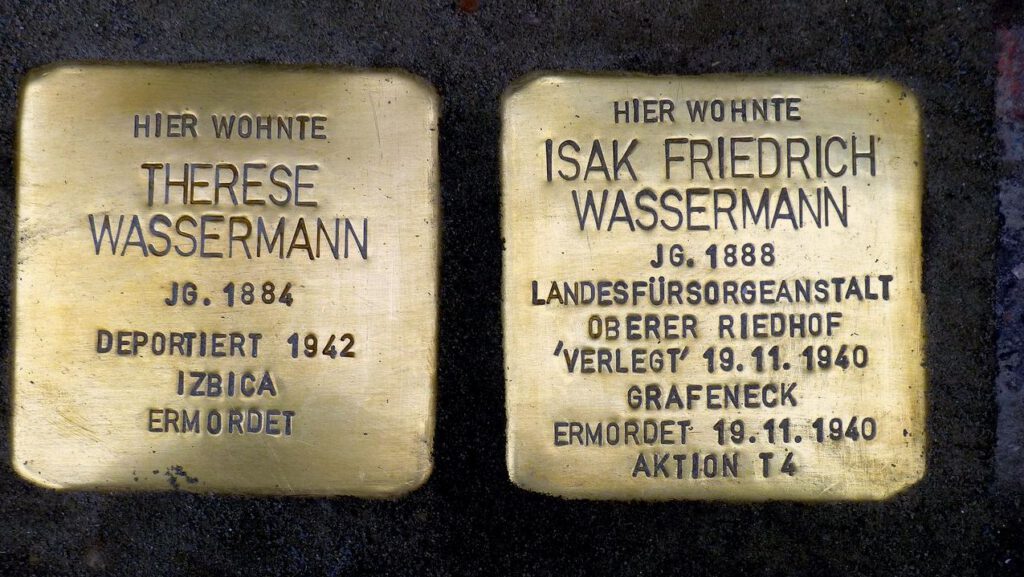
Living for a Kiosk?
Therese Wassermann was certainly a widely known Göppinger woman. From 1912 to 1936, she stood almost daily in her small sales kiosk at Untere Marktstraße 9a next to the former inn ‘Zum Bären’ and offered tobacco products and newspapers.
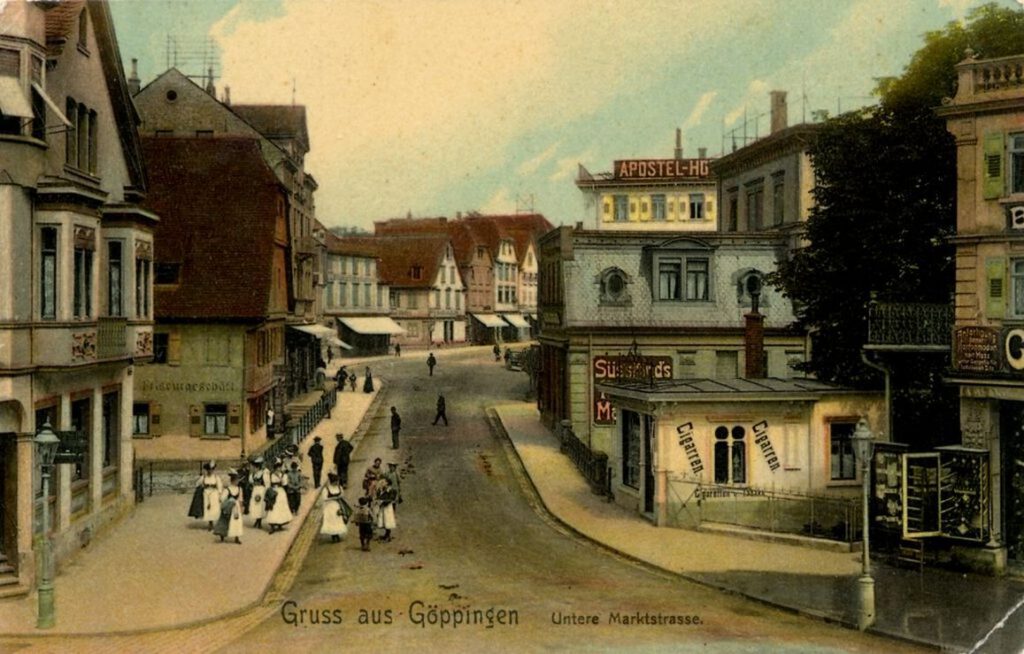
When David Löw Wassermann bought the kiosk for his eldest daughter Therese in 1912, he probably had her material security in mind. He and his family were probably not very wealthy, and at the age of 28 Therese was almost an ‘old maid’ by the standards of the time, with little chance of marriage. By the way, father Wassermann only financed the kiosk building, the building site remained in the possession of the Scheer family.
Therese Wassermann’s small business held up rather poorly financially: Emil Schober, owner of a tobacco wholesaler in Esslingen, wrote in 1953 as part of the restitution proceedings:
“Miss Therese Wassermann, Goeppingen had no assets at the time when I began the business relationship with her in about 1928. She would have had to give up her business at that time because she had no credit and was no longer supplied by the manufacturing companies. Representatives of these companies approached me at that time with the request to supply Ms. W. with commission goods so that she could keep her existence. I did this and the existing warehouse belonged to me from the beginning of the business relationship until the end, so Ms. W. did not have a warehouse that belonged to her. ( … ) On July 31, 1936, Ms. Wassermann gave up the business due to illness and deregistered. She could not sell the business, because nothing but an old counter and an old shelf belonged to her.”
This outlines the economic course of Therese’s business, but what does not come into view: Did Therese also experience happiness in her profession? Did she have friendly encounters with customers? In 1936, the pressure of the Nazis on a ‘Jewish’ micro-business of this kind was probably not decisive, probably Therese Wassermann was actually so ill that she had to give up.
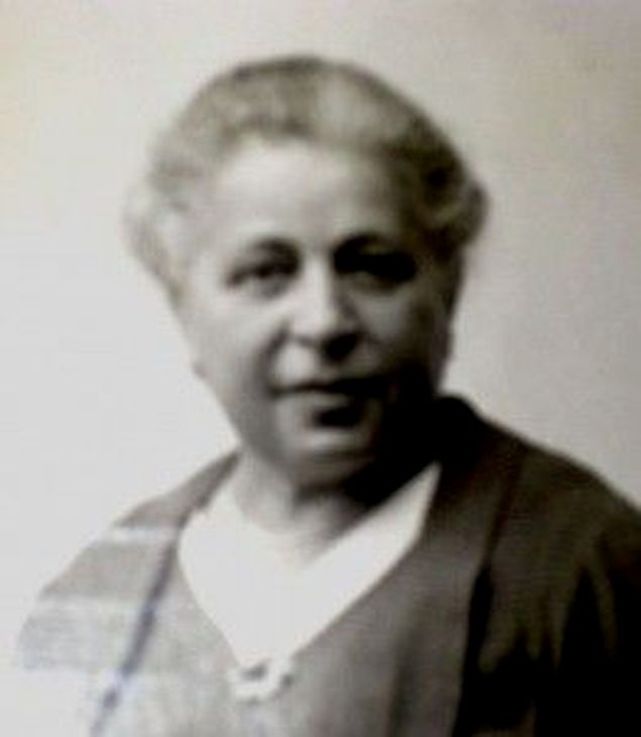
Berta Henle, a contemporary witness from Göppingen, recalled that Therese had suffered from ‘dropsy’ (probably a consequence of heart failure – the author). Did Therese find another job? Who helped her financially after she had to give up the income from the kiosk in mid-1936? At this time Therese changed her apartment and moved to Rosenstr. 13, a house on Rosenplatz, which belonged to the widow Maria Keidel.
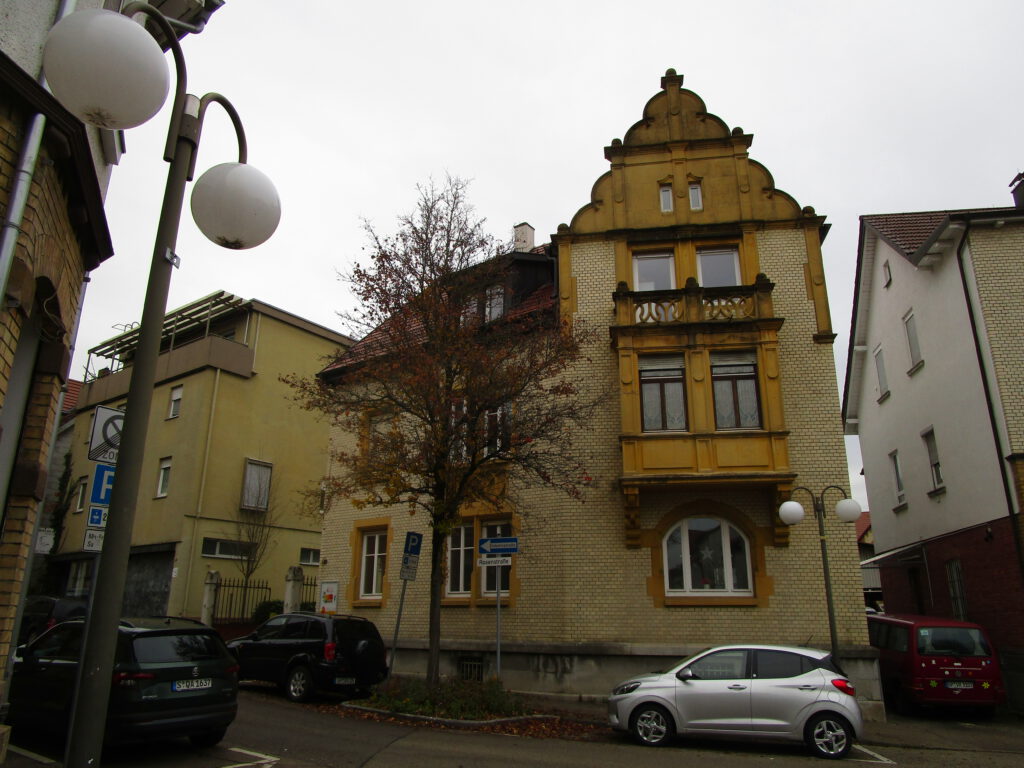
Family Wassermann
A look at her family: Around 1891 Therese’s parents, Bertha Wassermann, née Frei (Frey) and her husband David Löw Wassermann had moved from Aufhausen (today the town of Bopfingen) to Göppingen. The children Therese, born in 1884, Arthur, born in 1887, Isaak, born in 1888 and Berta Lina, born in 1890 moved with their parents to Kirchstr.12, where they found an apartment on the second floor in the house of the master baker Karl Berner. Another sibling, Karoline, born in 1885, had died in 1891 still in Aufhausen, in Göppingen the couple was to give birth to five more children.
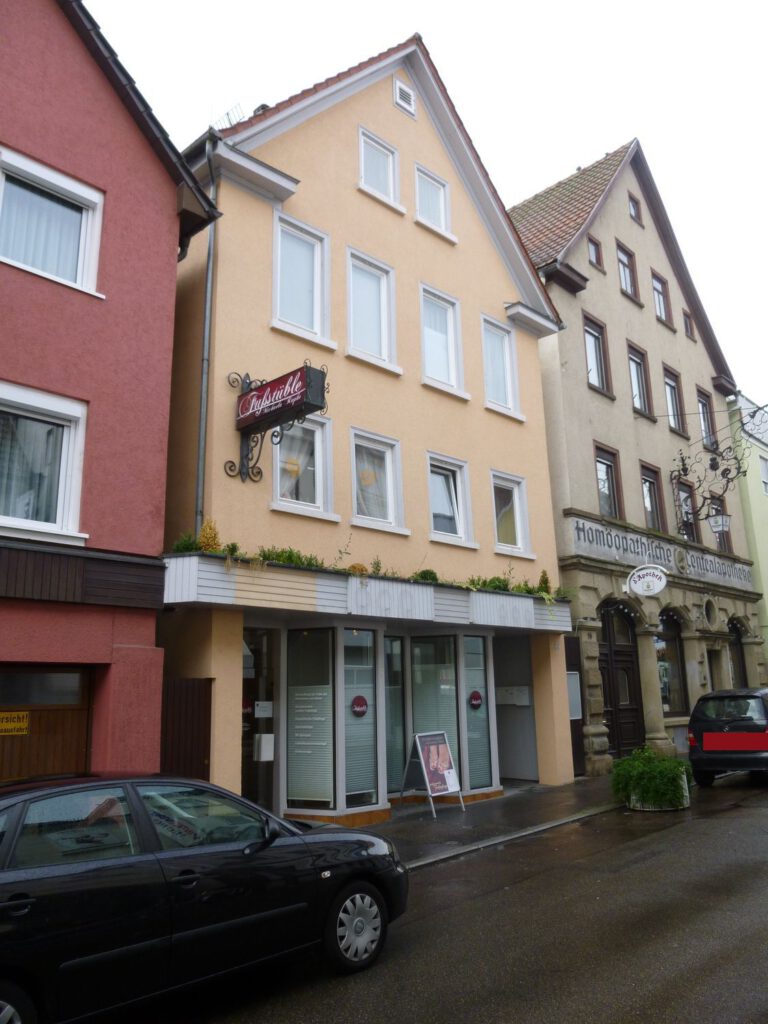
In the Goeppingen address book of 1902, David Löw Wassermann is described as a cattle dealer. While there is no reference in Rabbi Aron Tänzer’s book, Goeppingen resident Berta Henle recalled: “In Kirchstraße next to the Mauch pharmacy, Wassermann family, cattle drover, large family, very poor.” In 1936, five of the original 10 children were still alive, one of them, Isaak was then in the Ulm welfare institution ‘Oberer Riedhof’ as a mentally ill person. Not all siblings might have remained poor: Therese’s sister Berta Lina had been married to the (Christian) engineer Emil Munz since 1917 and the youngest brother Julius Wassermann, born in 1901, had already built his own house in Eugenstraße 10 in 1926. Presumably Therese was supported by her siblings after the end of her business activities.
The attachment to the Jewish community was probably not very pronounced in the family, at least no one participated in the institutions of the community. It was still the exception at that time that three of the four married Wassermann siblings had chosen a non-Jewish spouse.
The Fate Of The Wassermann Brothers And Their Families
For the racist Nazis, of course, it was beside the point how a person who was ‘Jewish’ according to their categories defined himself. Therese’s youngest brother Julius Wassermann, who was married to Hedwig, née Kocher, and whose children Heinz and Inge were baptized in his wife’s Protestant denomination, was the first to feel the racial hatred. A neighbor recalled his fate:
“On Kristallnacht (Pogrom Night on November 9, 1938, author’s note) Julius Wassermann was taken away. He was sent to the Dachau concentration camp with other Goeppingen Jews. There he was beaten and severely maltreated. When he returned after a few weeks (from 12.11. to 28.12.1938, author’s note), he had a whole back full of deep wounds. Before his release he had to sign a statement that he would not tell anyone about his treatment there. After this experience he only wanted to leave the country. It was clear to his wife that she would stand by him. The house, all the household goods were auctioned off at the beginning of 1939. The neighbors were upset, they had appreciated the family as neighbors. ( … ) At the beginning of 1939 this family only found a way out to Shanghai / China. Already on the ship they fortunately met members of the Seventh – Day Adventists. They were then their life savers in Shanghai. In the beginning the Wassermann family camped in parks in Shanghai. They were starving, searching in Chinese garbage cans for something to eat. It must have been terrible. There Seventh-day Adventists got them out and provided shelter and got them by.”
After the war, the family was able to emigrate to the USA. They had joined the Seventh-day Adventists.
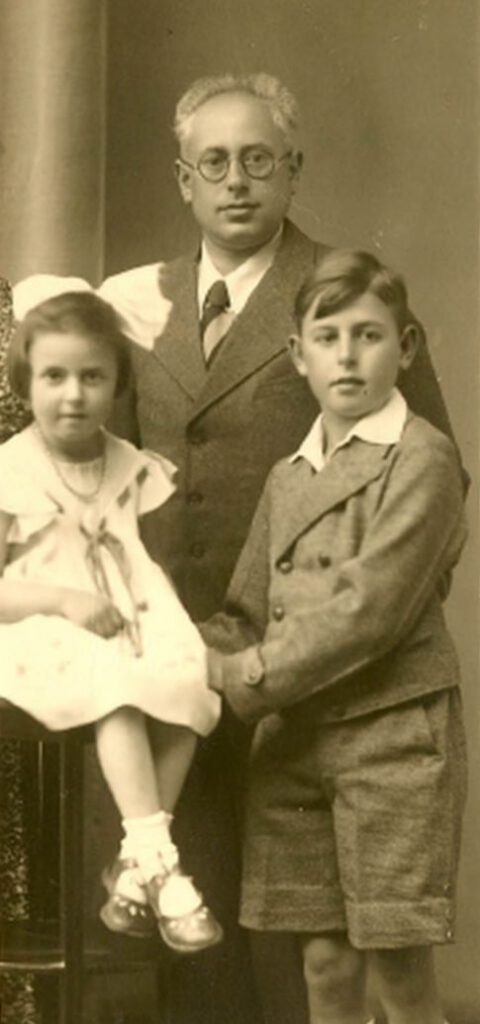
In August 1938 Berta Wassermann (widow of Arthur Wassermann, passed away in 1932) was able to flee to New York together with her son Kurt – even before Julius and his family escaped.
Another of Therese’s brothers, Alfred Wassermann, died in December 1940. He also had been married to a Christian woman. His widow, Mina Wassermann, née Weller, stayed in Göppingen with her ‘half-Jewish’ Protestant daughter Lore Beta. Lore married Capt. E. Harris, an American in 1949 and followed him to the USA.
Isaak Wassermann: Murdered Due To Mental Illness
The first murder victim in the Göppingen Wassermann family was Isaak, born in 1888, who lived in the state welfare institution ‘Oberer Riedhof’ near Ulm because of a mental illness. Presumably he had been in a sanatorium (psychiatric hospital) before, where he was diagnosed and treated. Apparently, a sufficient improvement was not achievable, so that Isaak was committed to the ‘Oberer Riedhof’ as a chronically ill person. The only surviving memory of him is that he was nicknamed “Jud Süß” in the ‘Oberer Riedhof’, a nonsensical, anti-Semitic allusion to the Jewish Württemberg financial advisor Jud Süß Oppenheimer, who was executed at the end of the 18th century after an unfair trial.
In this nickname, Isaak Wassermann’s gruesome end is basically already anticipated. The ‘Obere Riedhof’, which was originally a Christian institution, could not escape the ideological ‘Gleichschaltung’ by the Nazis. An indomitable employee pointed out the signs of decay and neglect in social life and in the treatment of the patients. The terminally ill were no longer to be protected and cared for, but were regarded by the Nazis as “ballast existences” which the “healthy body of the people” could not be expected to maintain. Like thousands of mentally ill people, Isaak was also killed in the murder operation, which was called ”euthanasia” in the Nazis’ obfuscating jargon. His life ended by gas in the Grafeneck extermination facility on August 23, 1940.
Therese’s Sister Lina: A Concentration Camp Survivor
Also threatened was the life of Therese’s sister Lina (actually: Berta Lina) Munz, who initially lived with her Protestant husband Emil at Nödlichen Ringstr. 24, where her brother-in-law August Munz ran the restaurant ‘Liederhalle’.
A friend of the family remembered Emil Munz: “He was often asked to divorce his Jewish wife. But he always stood by her. ( … ) She was a cheerful woman who simply resisted many a regulation. She did not wear the star, as her niece told me. She always had people in the house and in the neighborhood who helped her and stood by her. Her husband was taken to a labor camp in Leimbach near Eisleben before her, probably in January 1945 (but actually already on Nov. 20, 1944 – the author). Reason: The Jewish wife. Only after that she (= Mrs. Munz, the author) also received the emigration order: I still remember that my housewife gave her sister-in-law a warm woolen blanket. She came to Thersesienstadt with the conviction that she would come home again, and with her confidence she also helped others there to hold out.”
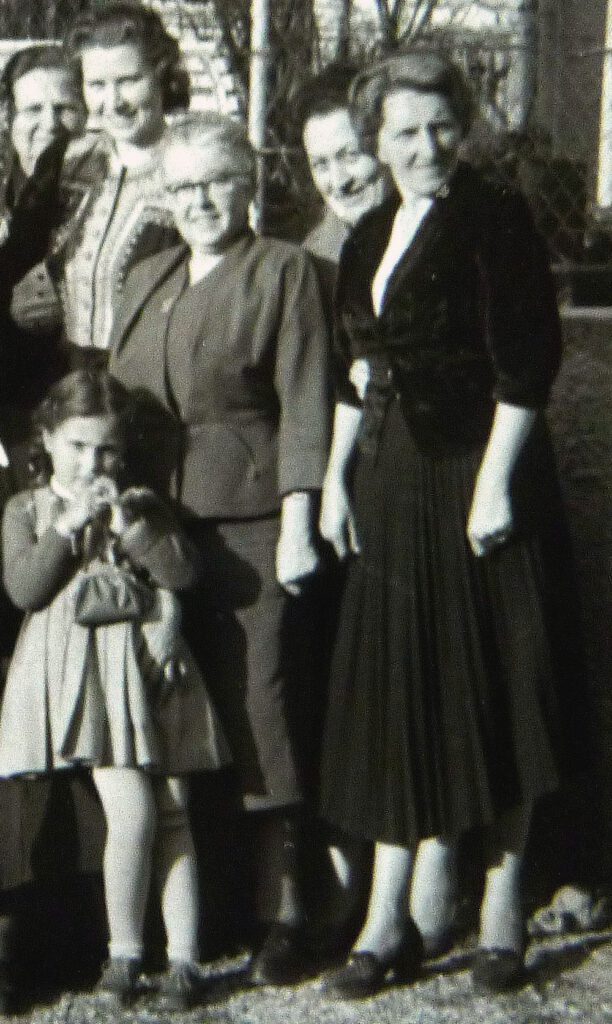
Lina Munz describes her liberation as follows: “On May 9, 1945, we were liberated by the advancing Russian troops. An SS – man from the guarding team, who was later sentenced to death and hanged in Austria, later testified to the Swiss Red Cross that we were to be gassed as of May 10, 1945.”
Lina Munz remained a resident of Göppingen at Rosenstr. 13 until her death in 1966. For a long time, her memoirs were the most important source of information about the crimes of the Nazis in Göppingen. She was also the one who took in 18-year-old Richard Fleischer when he arrived back in his native town in October 1945 after four years of torture and forced labor (see his report following the Stolperstein biography of Irma and Julius Fleischer).
Therese‘s Deportation to Izbica
Therese Wassermann was caught up in the deportation action of April 26, 1942, when about 300 Jewish men and women were deported from Stuttgart to the camp in Izbica near Lublin in Poland. On this deportation transport there also were other people from Göppingen: the Oppenheimer couple, the Schwab couple with their 13-months-old daughter Hannacha, and Sofie Simon, who was single.
Lina Munz wrote about her sister: “I have not received any sign of life from her since she was deported from Göppingen on April 24, 1942. Only Mrs. Marianne Schwab, wife of Max Schwab, who was on the same transport, once wrote me a postcard from near Lublin. I answered this card and asked in it about the fate of my sister Therese. Since that time I have heard nothing from Mrs. Schwab or from my sister. Also the inquiries made in the post-war period and search messages on the radio remained without success.”
After the war, there was no restitution in favor of Therese’s heirs, because the defendants were able to prove beyond doubt that the property in question had no longer belonged to Therese Wassermann even before the Nazi era. Only a letter from Lina Munz to the District Administrator Erich Krauss has survived, in which she asks that her sister’s furniture, which the tax office had confiscated after her deportation, be returned to her.
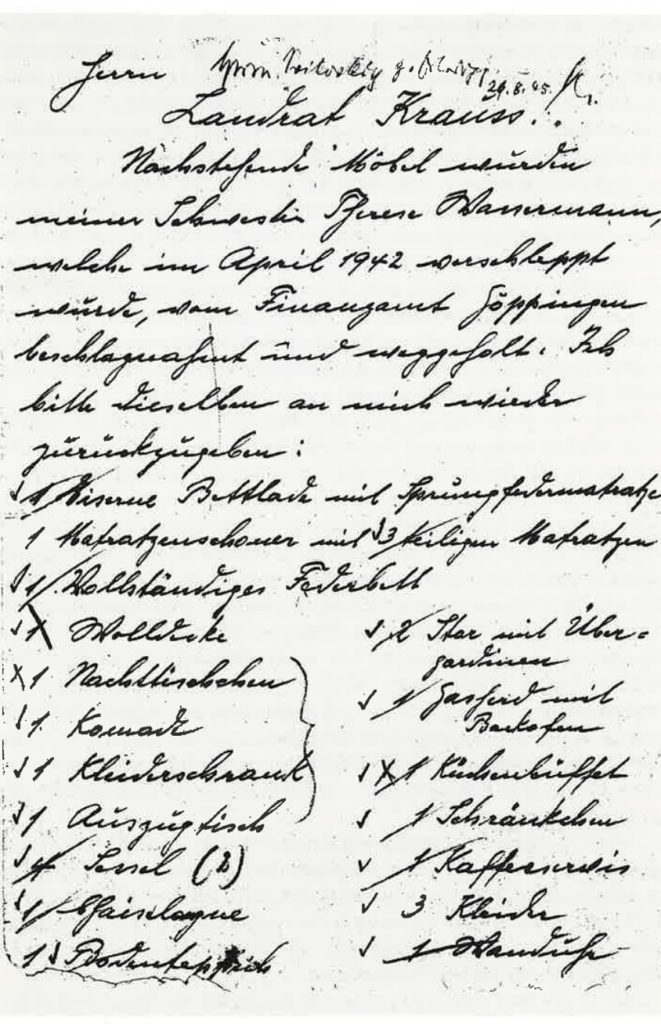
Other Murder Victims of the Family
In addition to Therese and Isaak Wassermann, there were other murder victims in the family, but most of them did not live in Göppingen:
Recha (Rosa) Frey, who earned her living as a nurse and housekeeper, was first taken to the Theresienstadt concentration camp in August 1942, but was murdered in the Treblinka extermination camp at the end of September of that year.
Johanna Frey, who also lived in Göppingen for a time, died on September 1, 1942 from the murderous living conditions in the Theresienstadt concentration camp. Both were half-sisters of Therese and Isaak’s mother.
Terribly the Nazis raged among Therese’s and Isaac’s cousins:
Joachim Wassermann and his wife Johanna, who lived in Frankfurt a. M., were deported to the Theresienstadt concentration camp in 1942. Johanna died there, her husband was murdered two years later in the Auschwitz extermination camp.
The unmarried cousin Alfred Wassermann, who still lived in the community of origin Aufhausen/Bopfingen, died in the camp Riga/Jungfernhof.
Adolf Wassermann lived with his wife Elise and their son Julius and daughter Ruth in Bopfingen and Oberdorf am Ipf. Adolf, Elise and Julius were murdered in Auschwitz in July 1942, daughter Ruth survived imprisonment in the Theresienstadt concentration camp.
Bernhard Wassermann was deported from his home in Magdeburg to the Warsaw Ghetto where he died in April 1942.
His mentally ill brother Isaak Wassermann was murdered in Grafeneck in 1940, as was his cousin of the same name from Göppingen.
Ida Wassermann was the name of an unmarried cousin who had also stayed in Aufhausen. From there she was deported to Riga/Jungfernhof in December 1941 and murdered.
Gunter Demnig laid the Stumbling Stones for Isaak and Therese Wassermann in front of the house Kirchstraße 12 on May 16, 2014. The speech for Therese Wassermann was held by Jordanos and Zara, students of the Hermann-Hesse-Realschule in Göppingen.
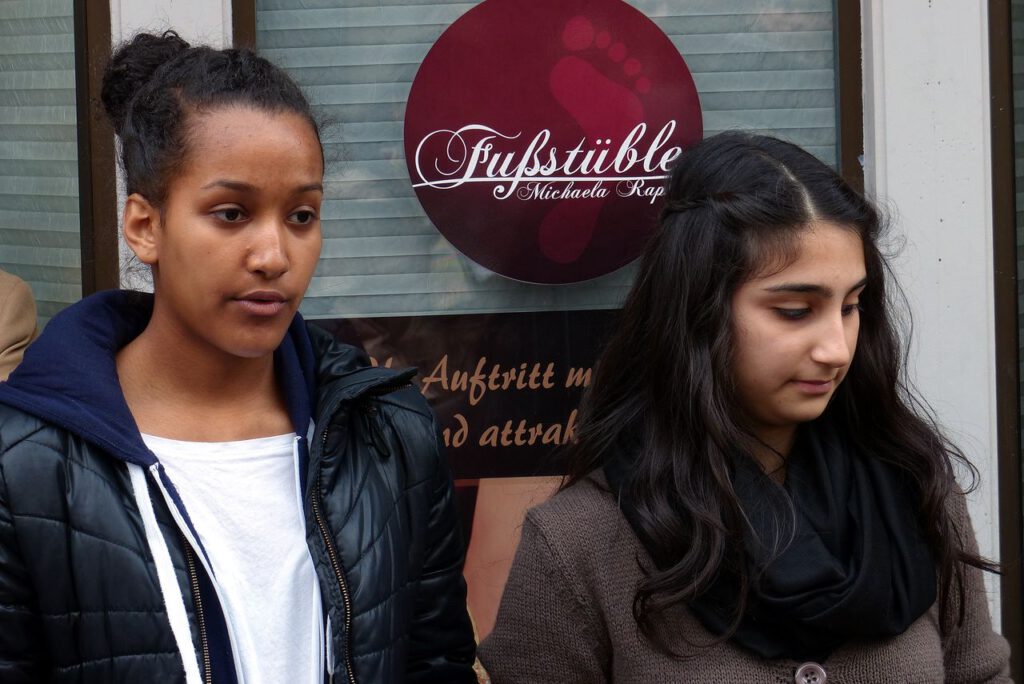
Jim and Barbara Hilb from the Wassermann / Hilb family traveled from the USA and participated in the ceremony.
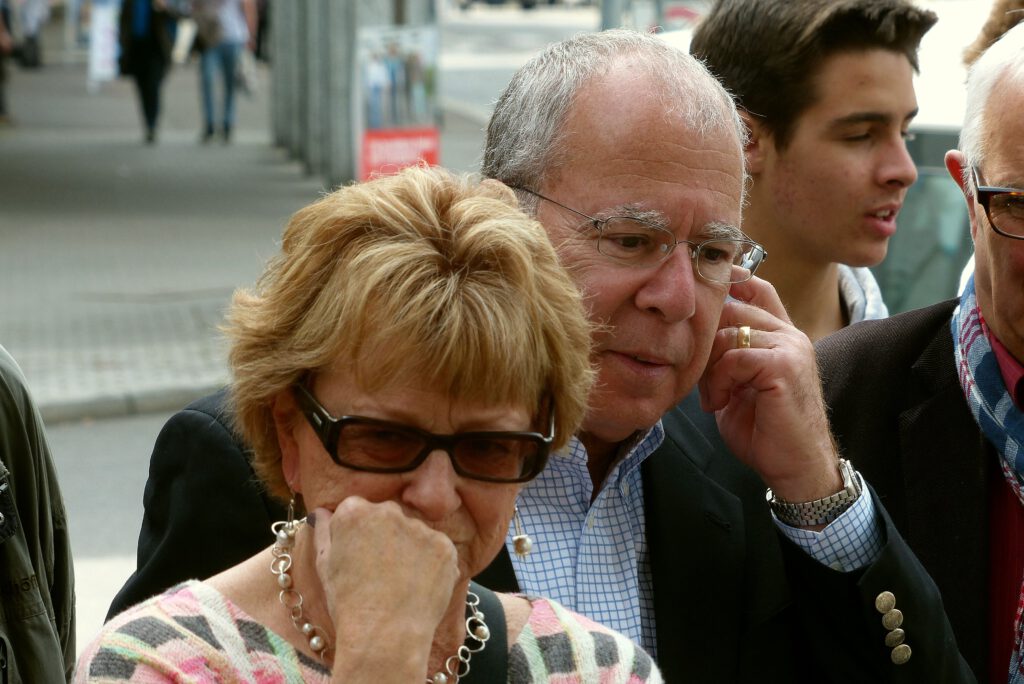
The Stolperstein-Initiative thanks Mr. Berner and Mr. and Mrs. Zoller for their information. The photos of the family were kindly provided by Glenn Wassermann and Inge and Steven J. Junghans, descendants of Julius and Hedwig Wassermann.
(01.12.2022 kmr/fw/pr)















I believe that my grandmother may have been a part of this Wasserman family. Can anyone contact me?
Her name was “emma wasserman” born circa 1891. Mom was an only child (so she was led to believe). My mom just passed but I am still trying to solve the mystery.